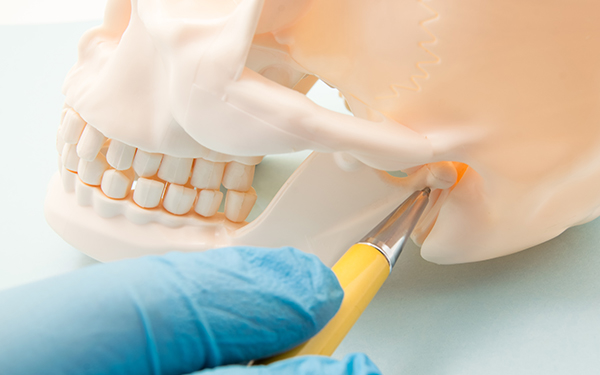TMJ Disorder
Temporomandibular joint (TMJ) disorder causes pain, clicking, and dysfunction of the muscles and joints that connect the lower jaw to the skull. The abbreviation “TMJ” literally refers to the joint but is often used to mean any disorders or symptoms of this region. TMJ-related symptoms are caused by physical stress on the teeth, the disk of cartilage within the joint, muscles of the neck and face, and the adjacent ligaments, nerves, and blood vessels.
Many people have contracted muscles (aka trigger points) in the jaw, head, and neck which can refer pain to other areas resulting in headaches, earaches, toothaches, or neck pain. Other frequent causes of TMJ include arthritis, fractures, dislocations, and structural problems present since birth.
Symptoms & Diagnosis
People with TMJ dysfunction often experience severe pain and discomfort that can be temporary or last for many years. More women than men experience the disorder, and it occurs most commonly in those between 20-40 years of age.
Seemingly unrelated problems can appear intermittently and may include:
- Biting or chewing difficulty or discomfort
- Clicking, popping, or grating sounds upon opening or closing of the mouth
- Dull, aching pain in the face or neck
- Earache or tinnitus
- Headache or balance issues
- Pain, locking, or tenderness of the jaw
Medical Treatment
Common pharmaceutical options involve short-term use of acetaminophen (Tylenol), ibuprofen (Advil and Motrin), naproxen (Aleve), muscle relaxants, antidepressants, and corticosteroid shots. Splints or bite guards have been used since the 1930s to treat teeth grinding (bruxism), clenching, and TMJ disorders. While many people have found them to be useful, the benefits can vary widely. Bite guards may eventually lose effectiveness over time or when use is discontinued. Some people may even feel increased pain upon use of a bite guard.
Joint replacement or reconstructive surgery of the jaw is rarely required, and studies have shown that post-surgical results are sometimes worse than the original presentation.

Conservative chiropractic care can ease or eliminate pain by correcting the misalignment between the jaw, the skull, and the cartilage within the temporomandibular joint.
At Divine Design Natural Health, our treatments are effective at reducing the pain associated with TMJ either when used alone or in addition to other treatments. The muscles both inside and outside the mouth can be addressed in order to relieve chronic trigger points. We then use cold laser therapy and mild realignment procedures to address the cartilaginous disk within the joint. Improvements in balance, tinnitus, neck pain, and headaches are closely associated with effective TMJ treatment and can often be long-lasting and surprising benefits of our conservative natural healthcare.



